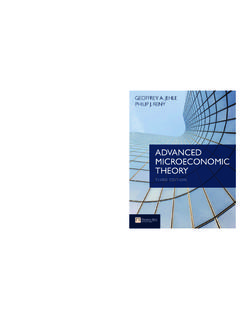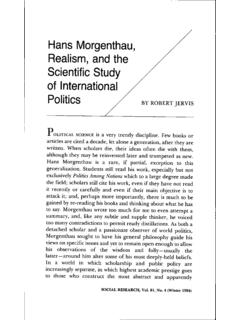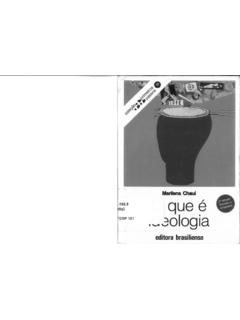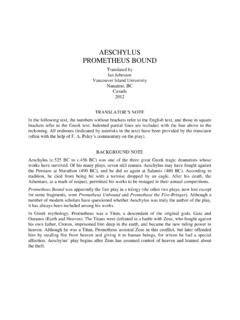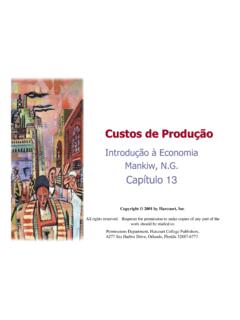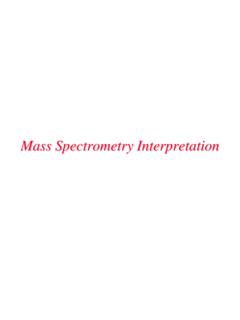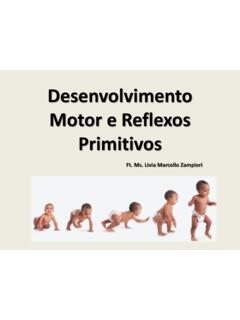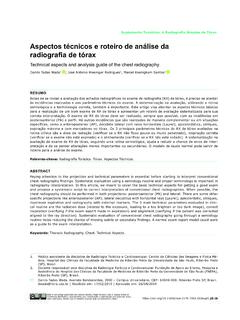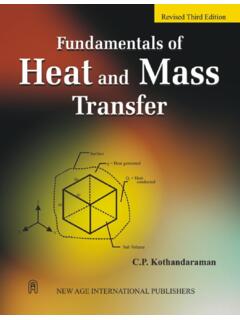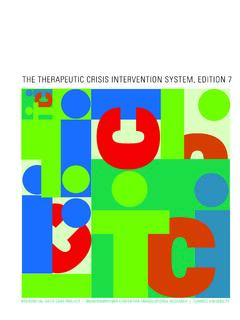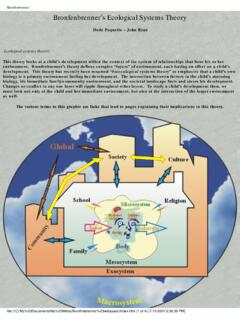Transcription of Urie Bronfenbrenner’s Theory of Human Development: Its ...
1 EDINETE MARIA ROSA Federal University of Esp rito Santo, Brazil JONATHAN TUDGE University of North Carolina, Greensboro . Urie bronfenbrenner 's Theory of Human development : Its Evolution From Ecology to Bioecology We describe the evolution, over three phases, of the time it was first proposed in the 1970s until bronfenbrenner 's Theory from an ecological to bronfenbrenner 's death in 2005. It is therefore a bioecological Theory . Phase 1 (1973 1979) unfortunate that too many scholars treat the the- culminated in the publication of The Ecol- ory as though it deals solely with the influence ogy of Human development (1979).
2 Phase 2 of context on children's or adolescents' devel- (1980 1993) saw almost immediate modifica- opment and take no account of what came to be tions to the Theory , with more attention paid the central aspect of the Theory , namely proxi- to the role of the individual and greater con- mal processes, and how person characteristics, cern with developmental processes. In Phase 3 context, and historical time mutually influence (1993 2006), proximal processes were defined those processes (see Tudge, Mokrova, Hatfield, and placed at the heart of bioecological Theory , & Karnik, 2009).
3 Moreover, although Bronfen- and from 1998, the Process-Person-Context- brenner described it as a Theory of Human devel- Time (PPCT) model was described as the opment, from the start the developing individual Theory 's appropriate research design. Given the was consistently viewed as influencing, and extent of these changes, and to avoid theoretical being influenced by, the environment. The fam- incoherence, scholars should be cautious about ily thus plays a key role: it does so as a microsys- stating that their research is based on Bron- tem context in which development occurs; it fenbrenner's Theory without specifying which does so in terms of the personal characteristics version they are using.
4 Of all individuals in the family; and most impor- tant, it does so in terms of the interactions among family members as part of proximal processes. Urie bronfenbrenner 's Theory of Human devel- It is also important to point out that although opment underwent considerable changes from bronfenbrenner may be best known as the developer of the Theory that we describe in this article, he was also intensely interested in the Postgraduate Program in Psychology, Federal University of family as an institution. During the years that he Esp rito Santo, Brazil was developing his Theory , he also wrote many Department of Human development and Family Studies, papers on such topics as social-class influences 155 Stone, University of North Carolina, Greensboro, NC on child rearing, the effects of maternal 27402 employment on children's development , the Key Words: bioecological Theory , ecological Theory , Human problems associated with treating some families development , PPCT model, Urie bronfenbrenner .
5 As being at a deficit,'' and family policies that Journal of Family Theory & Review 5 (December 2013): 243 258 243. 244 Journal of Family Theory & Review are needed for families to grow healthily (for a of the characteristics and influences of different review, see Tudge, 2013). Most relevant is the contexts (microsystem, mesosystem, exosystem, fact that there was cross-fertilization between and macrosystem). According to Bronfenbren- his more family-oriented writings and those that ner and Evans, the following two phases each have a more theoretical focus. began with publications in the major handbooks The bioecological Theory of Human devel- of the day ( bronfenbrenner & Crouter, 1983.)
6 Opment, initially termed an ecological model bronfenbrenner & Morris, 1998). or approach, was originally proposed by Bron- Our dating of the phases is necessarily fenbrenner to explain how Human development somewhat imprecise, as we rely on date of occurs, focusing largely on the impact of con- publication rather than the date of writing text. Nonetheless, as denoted by his use of the and submission for publication. We have, for word ecology, bronfenbrenner clearly viewed example, identified 1993 as both ending the development as emerging from the interaction second phase and starting the third phase.
7 It of individual and context. Subsequent refor- is quite clear, however, that whereas the ideas mulations of his original ideas resulted as he in bronfenbrenner 's 1993 chapter fit with those came to stress the role played by the individual; expressed in his other publications from 1980. the impact of time; and most important of all, onwards, his coauthored paper of the same proximal processes. date ( bronfenbrenner & Ceci, 1993) marked Bioecological Theory in its current or mature a dramatic shift in thinking. form specifies that researchers should study Regardless of the precise timing of these the settings in which a developing individual phases, what is absolutely clear is that the spends time and the relations with others in Theory underwent significant changes between the same settings, the personal characteristics of its inception and its final state.
8 Unfortunately, the individual (and those with whom he or she as Tudge et al. (2009) pointed out, this fact has typically interacts), both development over time been ignored by many scholars. Tudge et al. and the historical time in which these individuals analyzed 25 studies published between 2001. live, and the mechanisms that drive development and 2008 ( , well after the beginning of the (proximal processes). final stage in the Theory 's development ), whose From a methodological point of view, authors stated that their research was based on bioecological Theory privileges the study of bronfenbrenner 's Theory .
9 Of those, only four proximal processes that are likely to lead to were based on the most recent form of the healthy development , with the developing Theory , and most described the Theory simply individuals of interest being distinguished in as one of contextual influences on development , at least one relevant individual characteristic completely ignoring the centerpiece of the Theory and studied in more than a single context in its final incarnation: proximal processes. As (almost always the typical settings in which Tudge et al. argued, there is nothing wrong with the individuals are to be found).
10 The Theory deliberately basing one's research on an earlier was formulated, as bronfenbrenner expressed version of the Theory or even on a subset of its it, to examine not the forces that have shaped key concepts; however, for theoretical confusion Human development in the past, but .. those to be avoided, one should be explicit about the that may already be operating today to influence specific theoretical basis for the study. Equally what Human beings may became tomorrow'' important, scholars should pay greater attention ( bronfenbrenner & Evans, 2000, p. 117). to the fact that while theorists are still alive and bronfenbrenner was a theorist who ques- publishing, their theories are likely to develop.
